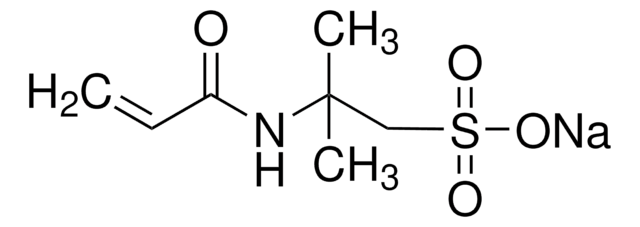If this product has an expiration or retest date, it will be shown on the Certificate of Analysis (COA, CofA). If there is no retest or expiration date listed on the product's COA, we do not have suitable stability data to determine a shelf life. For these products, the only date on the COA will be the release date; a retest, expiration, or use-by-date will not be displayed.
For all products, we recommend handling per defined conditions as printed in our product literature and website product descriptions. We recommend that products should be routinely inspected by customers to ensure they perform as expected.
For products without retest or expiration dates, our standard warranty of 1 year from the date of shipment is applicable.
For more information, please refer to the Product Dating Information document: https://www.sigmaaldrich.com/deepweb/assets/sigmaaldrich/marketing/global/documents/449/386/product-dating-information-mk.pdf
448281
(3-Acrylamidopropyl)trimethylammonium chloride solution
75 wt. % in H2O
Synonyme(s) :
(Acrylamidopropyl)trimethylammonium chloride, Acryloylaminopropyltrimethylammonium chloride, Trimethyl(3-acrylamidopropyl)ammonium chloride
About This Item
Produits recommandés
Contient
3,000 ppm monomethyl ether hydroquinone as stabilizer
Concentration
75 wt. % in H2O
Indice de réfraction
n20/D 1.4848
Densité
1.11 g/mL at 25 °C
Température de stockage
2-8°C
Chaîne SMILES
[Cl-].C[N+](C)(C)CCCNC(=O)C=C
InChI
1S/C9H18N2O.ClH/c1-5-9(12)10-7-6-8-11(2,3)4;/h5H,1,6-8H2,2-4H3;1H
Clé InChI
OEIXGLMQZVLOQX-UHFFFAOYSA-N
Catégories apparentées
Description générale
Application
- As a cationic monomer to synthesize polyampholyte hydrogels (PAHs). These hydrogels show pH-responsive and ionic strength-responsive behavior and are suitable for application in smart coatings and biosensors.
- As a monomer to prepare poly(APTAC) ion exchange membranes with high surface porosity, for the removal of Cu(II), Cr(VI), and As(V) ions from water.[1]
- As a precursor to fabricate cartilage mimetic polymer scaffolds that can be used in cartilage regeneration and replacement.[2]
Mentions de danger
Conseils de prudence
Classification des risques
Aquatic Chronic 3
Code de la classe de stockage
10 - Combustible liquids
Classe de danger pour l'eau (WGK)
WGK 1
Point d'éclair (°F)
Not applicable
Point d'éclair (°C)
Not applicable
Faites votre choix parmi les versions les plus récentes :
Déjà en possession de ce produit ?
Retrouvez la documentation relative aux produits que vous avez récemment achetés dans la Bibliothèque de documents.
Les clients ont également consulté
-
How can I determine the shelf life / expiration / retest date of this product?
1 answer-
Helpful?
-
-
How is shipping temperature determined? And how is it related to the product storage temperature?
1 answer-
Products may be shipped at a different temperature than the recommended long-term storage temperature. If the product quality is sensitive to short-term exposure to conditions other than the recommended long-term storage, it will be shipped on wet or dry-ice. If the product quality is NOT affected by short-term exposure to conditions other than the recommended long-term storage, it will be shipped at ambient temperature. As shipping routes are configured for minimum transit times, shipping at ambient temperature helps control shipping costs for our customers. For more information, please refer to the Storage and Transport Conditions document: https://www.sigmaaldrich.com/deepweb/assets/sigmaaldrich/marketing/global/documents/316/622/storage-transport-conditions-mk.pdf
Helpful?
-
-
Why is this sold as a 50% wt soln in water? Is it stable as a solid?
1 answer-
The compound (3-Acrylamidopropyl)trimethylammonium chloride is generally sold in solution, i.e. in a liquid form vs a dry form, to facilitate the addition of a stabilizer against premature polymerization. For this product, it is 3,000 ppm monomethyl ether hydroquinone that is used as a stabilizer.
Helpful?
-
Active Filters
Notre équipe de scientifiques dispose d'une expérience dans tous les secteurs de la recherche, notamment en sciences de la vie, science des matériaux, synthèse chimique, chromatographie, analyse et dans de nombreux autres domaines..
Contacter notre Service technique![[2-(Acryloyloxy)ethyl]trimethylammonium chloride solution 80 wt. % in H2O, contains 600 ppm monomethyl ether hydroquinone as inhibitor](/deepweb/assets/sigmaaldrich/product/structures/393/326/f7e19585-5431-4220-81b5-f458de6d63d0/640/f7e19585-5431-4220-81b5-f458de6d63d0.png)
![[2-(Methacryloyloxy)ethyl]trimethylammonium chloride solution 75 wt. % in H2O](/deepweb/assets/sigmaaldrich/product/structures/316/612/66b0f4cf-d060-427d-b4f5-e8fab3e5cffe/640/66b0f4cf-d060-427d-b4f5-e8fab3e5cffe.png)
![[3-(Methacryloylamino)propyl]trimethylammonium chloride solution 50 wt. % in H2O](/deepweb/assets/sigmaaldrich/product/structures/189/736/089bc8ae-2a98-416d-9f9a-a0a510b6b828/640/089bc8ae-2a98-416d-9f9a-a0a510b6b828.png)


![[2-(Methacryloyloxy)ethyl]dimethyl-(3-sulfopropyl)ammonium hydroxide 95%](/deepweb/assets/sigmaaldrich/product/structures/217/219/73c91e1c-0ee4-4b3d-bead-a6dc3d09d1da/640/73c91e1c-0ee4-4b3d-bead-a6dc3d09d1da.png)









![N-[Tris(hydroxymethyl)methyl]acrylamide contains ≤7% KCl, 93%](/deepweb/assets/sigmaaldrich/product/structures/130/961/5bc6d1a4-a540-4496-9f46-74507af67e21/640/5bc6d1a4-a540-4496-9f46-74507af67e21.png)